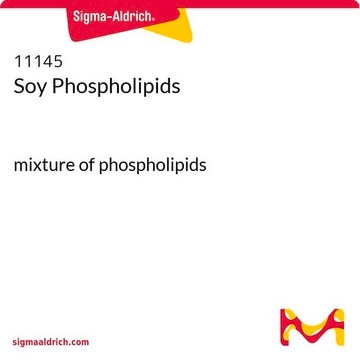429415
L-α-Lecithin
≥97% (choline basis), solid, lipotropic agent, Calbiochem
Synonym(e):
L-α-Lecithin, Sojabohne
About This Item
Empfohlene Produkte
product name
L-α-Lecithin, Sojabohne, L-α-Lecithin, Soybean, CAS 8002-43-5, is a concentrate of soybean lecithin consisting of more than 94% phosphatidylcholine and less than 2% triglycerides.
Qualitätsniveau
Form
solid
Hersteller/Markenname
Calbiochem®
Lagerbedingungen
OK to freeze
Farbe
light yellow
Löslichkeit
RPMI culture medium: 10 mg/mL, turbid
chloroform: 200 mg/mL
Versandbedingung
wet ice
Lagertemp.
−20°C
Allgemeine Beschreibung
Anwendung
Biochem./physiol. Wirkung
Verpackung
Warnhinweis
Rekonstituierung
Rechtliche Hinweise
Lagerklassenschlüssel
11 - Combustible Solids
WGK
WGK 1
Flammpunkt (°F)
Not applicable
Flammpunkt (°C)
Not applicable
Analysenzertifikate (COA)
Suchen Sie nach Analysenzertifikate (COA), indem Sie die Lot-/Chargennummer des Produkts eingeben. Lot- und Chargennummern sind auf dem Produktetikett hinter den Wörtern ‘Lot’ oder ‘Batch’ (Lot oder Charge) zu finden.
Besitzen Sie dieses Produkt bereits?
In der Dokumentenbibliothek finden Sie die Dokumentation zu den Produkten, die Sie kürzlich erworben haben.
Kunden haben sich ebenfalls angesehen
Artikel
Learn more about our culture media portfolio for microbial examination of non-sterile products, fully compliant with the harmonized Pharmacopoeia.
Unser Team von Wissenschaftlern verfügt über Erfahrung in allen Forschungsbereichen einschließlich Life Science, Materialwissenschaften, chemischer Synthese, Chromatographie, Analytik und vielen mehr..
Setzen Sie sich mit dem technischen Dienst in Verbindung.




